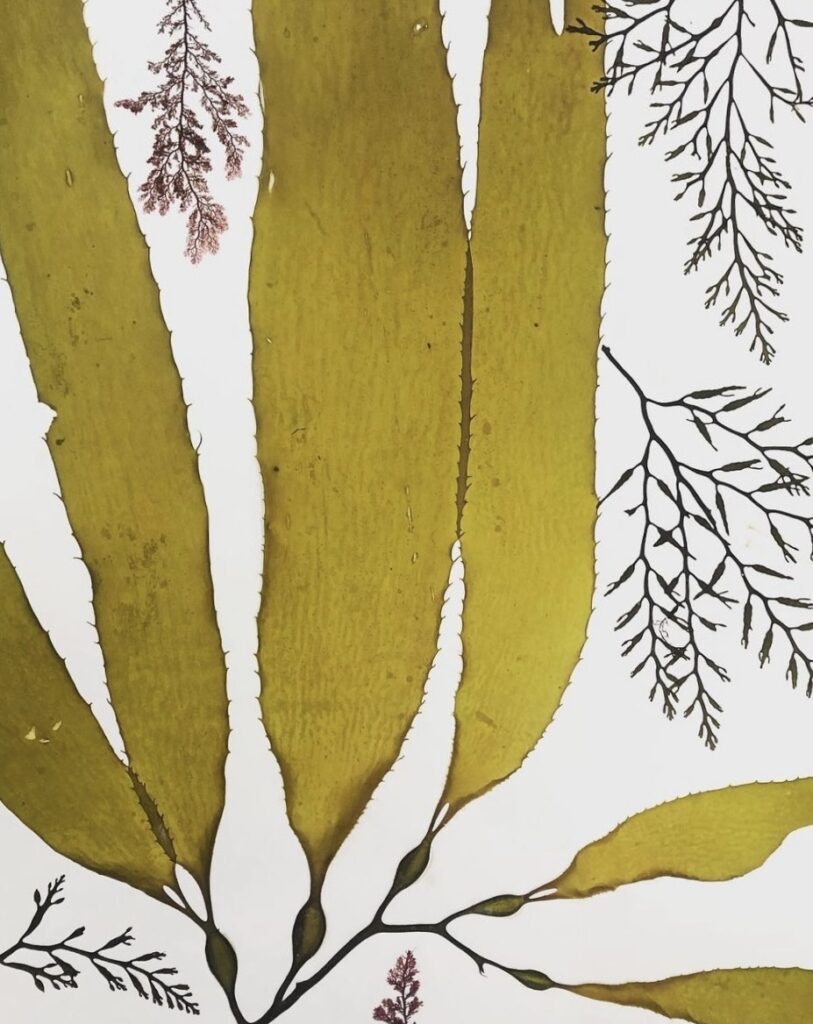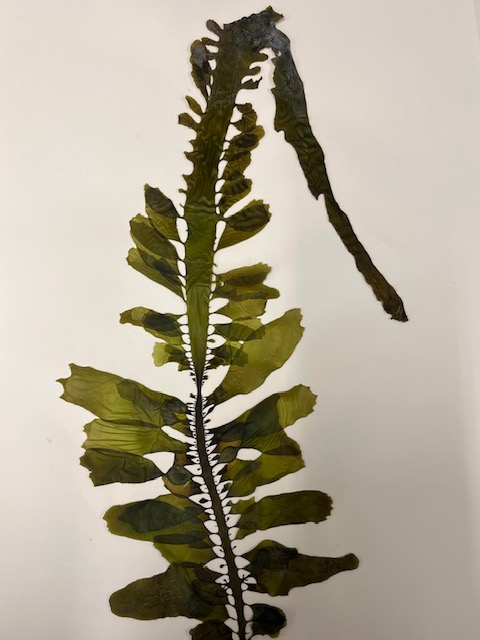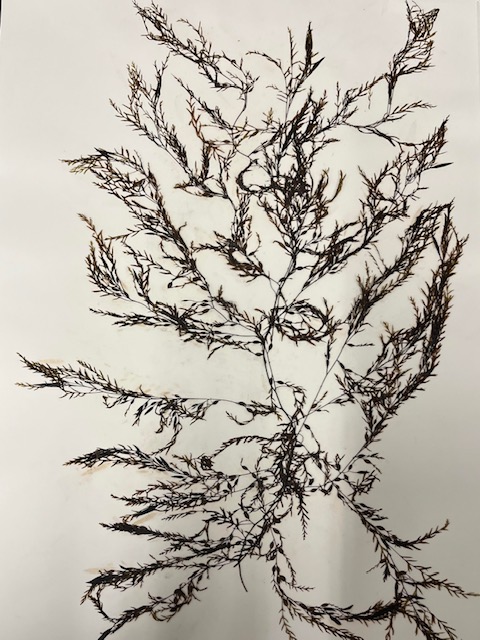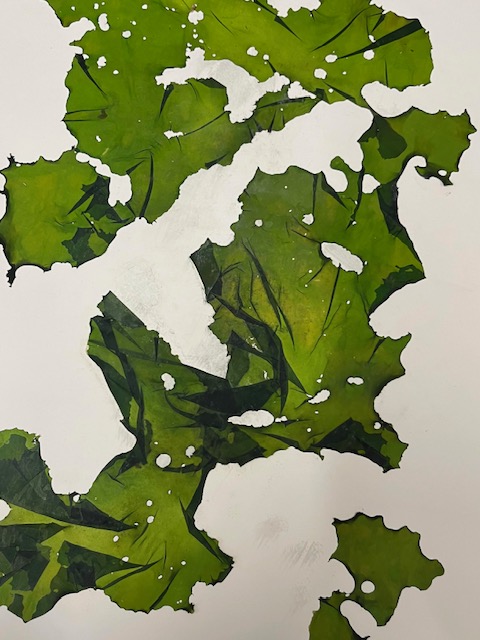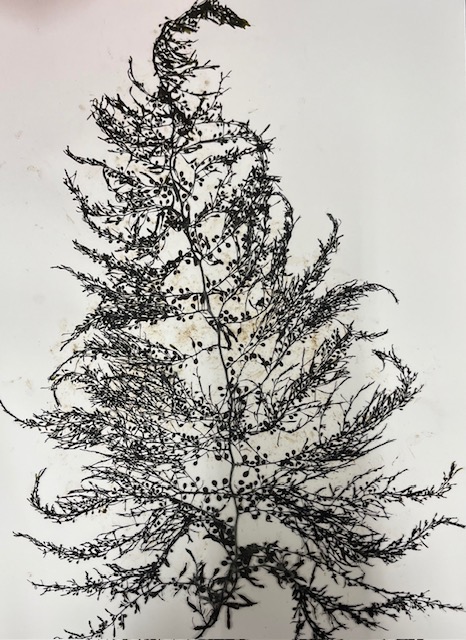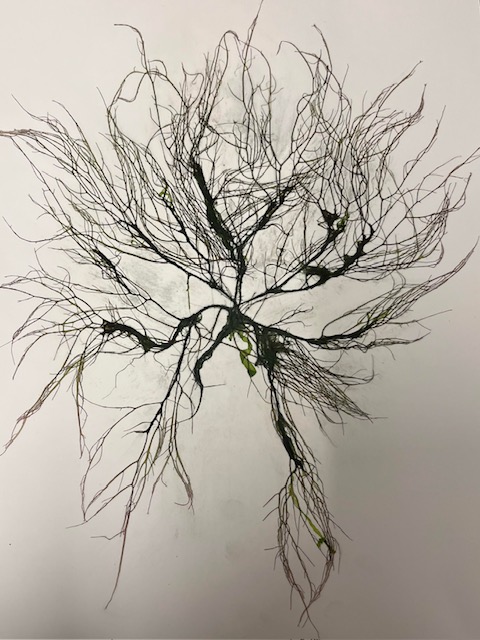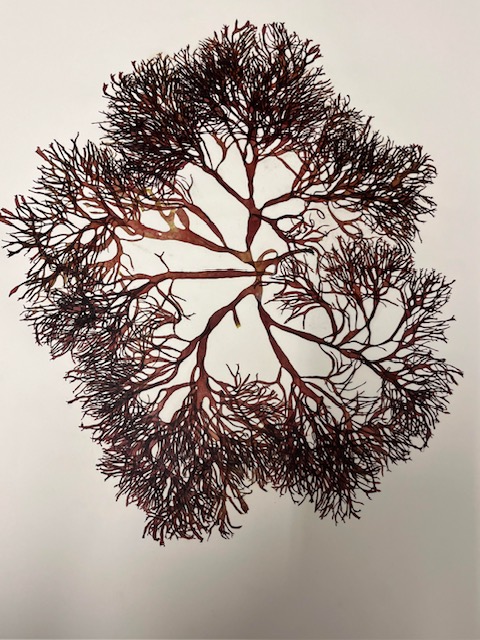Macrocystis pyrifera, commonly known as giant kelp, is one of the largest and fastest-growing species of brown algae, forming vast underwater forests in temperate coastal waters. It is native to regions like the Pacific coast of North and South America, where it provides critical habitat and shelter for a wide variety of marine species. This kelp has a complex structure with long, buoyant fronds that can reach over 30 meters in length, allowing it to capture sunlight efficiently for photosynthesis. M. pyrifera plays a vital role in coastal ecosystems by promoting biodiversity as an ecosystem engineer, stabilizing marine environments, and supporting commercial industries like fisheries and kelp farming. Its rapid growth and productivity make it a key species for carbon sequestration and ecosystem health.
Porphyra cuneiformis is a species of red algae commonly found in the intertidal zones along rocky coasts. It is a member of the order Bangiales, one of the oldest eukaryotic systems that dates back to ~1.6 billion years ago. It has thin, sheet-like fronds that are typically reddish or purplish in color and are highly adaptable to changing environmental conditions, such as tidal exposure and varying temperatures. This species is a preferred source of the red pigment r-phycoerythrin which is used as a fluorescent ‘tag’ in the medical diagnostic industry, as well as its large role in human consumption, particularly in products like nori. P. cuneiformis provides habitat and food for various marine organisms and plays a role in nutrient cycling within coastal ecosystems.
Egregia menziesii, commonly known as feather boa kelp, is a large intertidal brown seaweed found along the rocky shores of the Pacific coast of North America. It has a distinctive long, strap-like structure with branching fronds that resemble a feathered boa, which provides habitat and shelter for a variety of marine organisms. It is a kelp, as part of the order Laminariales, and has pneumatocysts like many other kelp species to assist in its buoyancy. In the intertidal zone it is exposed to both air and water, making it highly tolerant to changing environmental conditions such as tides and waves. E. menziesii plays a key role in coastal ecosystems by stabilizing substrates and supporting biodiversity. Its ability to regenerate after damage helps it persist in the dynamic coastal environment. It is also currently targeted as an aquaculture candidate given its palatability.
Sargassum horneri is a subtidal species of brown macroalgae native to the temperate waters of the western Pacific, around Japan and Korea. It has become an invasive species in other parts of the world, such as the eastern Pacific, including California and Mexico. This seaweed forms dense underwater forests that can outcompete native species by blocking sunlight and taking up space and nutrients, but current research shows that it is not outcompeting kelp. Its rapid spread and adaptability to various environmental conditions make it a threat to marine biodiversity and ecosystems, taking up unoccupied niches. It has distinct juvenile, intermediate, and adult sporophyte stages that vary morphologically as it loses blade area while developing more pneumatocysts (air bladders) throughout its life history stages.
Ulva lactuca, commonly known as sea lettuce, is a green macroalga found in coastal waters around the world, both intertidally and subtidally. It has thin, leafy, translucent fronds and typically grows in intertidal and shallow subtidal zones, where it can thrive in nutrient-rich environments. These blades are a mere two cells thick! This species is known for its rapid growth, especially in areas with high nutrient input, such as polluted waters, leading to algal blooms. Ulva has been found to successfully bioremediate waters containing heavy metals such as copper. During its reproductive stages, holes as seen here are visible. U. lactuca is also used in human cuisine and as a source of bioactive compounds in some industries.
Sargassum palmeri is a subtidal species of brown algae found primarily in the Gulf of California and along the Pacific coast of Mexico, especially prominent in the Channel Islands of California. It plays an important ecological role by providing habitat and food for various marine organisms with its rose-bush-like appearance. Unlike other species of Sargassum, S. palmeri is not known for forming large floating mats, but it can still form dense underwater forests. Its presence is vital for maintaining biodiversity in its native ecosystems, although changes in water conditions or human activity could impact its distribution. This species is sensitive to environmental shifts such as water temperature and nutrient availability. Like other Sargassum species, it contains pneumatocysts, or air bladders, that help its buoyancy to reach the surface to access as much light as possible.
Agardhiella subulata is a species of red algae commonly found in the Atlantic Ocean, particularly along the eastern coast of North America. It has dense, bushy fronds with a cylindrical, branched structure, and typically grows in shallow, sandy or rocky coastal waters. This algae is an important source of carrageenan, a polysaccharide used in the food and pharmaceutical industries as a thickening and stabilizing agent. A. subulata also provides habitat and food for various marine organisms, playing a role in supporting coastal biodiversity. Its resilience to varying environmental conditions makes it a significant species in the ecosystems it inhabits.
Halymenia hawaiiana is a species of red algae found in the waters around Hawaii and other tropical regions. It has soft, gelatinous fronds that are typically deep red in color and can grow in a variety of marine environments, from shallow reefs to deeper waters. This species plays a role in providing habitat and food for marine organisms, contributing to the overall health and biodiversity of coral reef ecosystems. H. hawaiiana is also studied for its potential use in biotechnology, particularly for its bioactive compounds. Its striking appearance and ecological importance make it a key part of the tropical marine flora.
Prionitis lanceolata is a species of red algae commonly found in the rocky intertidal and subtidal zones of the Pacific coast of North America. It has thick, blade-like fronds with a leathery texture, which help it withstand wave action and other environmental stresses. This seaweed provides habitat and food for various marine organisms, contributing to the biodiversity of coastal ecosystems. Like other red algae, P. lanceolata plays a role in nutrient cycling and can adapt to a range of light and water conditions. When exposed to excess light or during periods of excess exposure to air, it will ‘bleach’ and lose some pigmentation, as seen here.
Gracilaria parvispora is a species of red algae native to tropical and subtropical regions, including the Hawaiian Islands. Although tricky to identify, it has slender, branching fronds and grows in shallow marine environments, such as lagoons and coastal waters. This seaweed is valued for its role in aquaculture, particularly in the production of agar, a gelatinous substance used in food, biotechnology, and pharmaceuticals. G. parvispora also provides habitat for marine organisms and contributes to nutrient cycling in coastal ecosystems. Due to its commercial importance, it is cultivated in various regions, supporting both local economies and sustainable seaweed farming practices.

